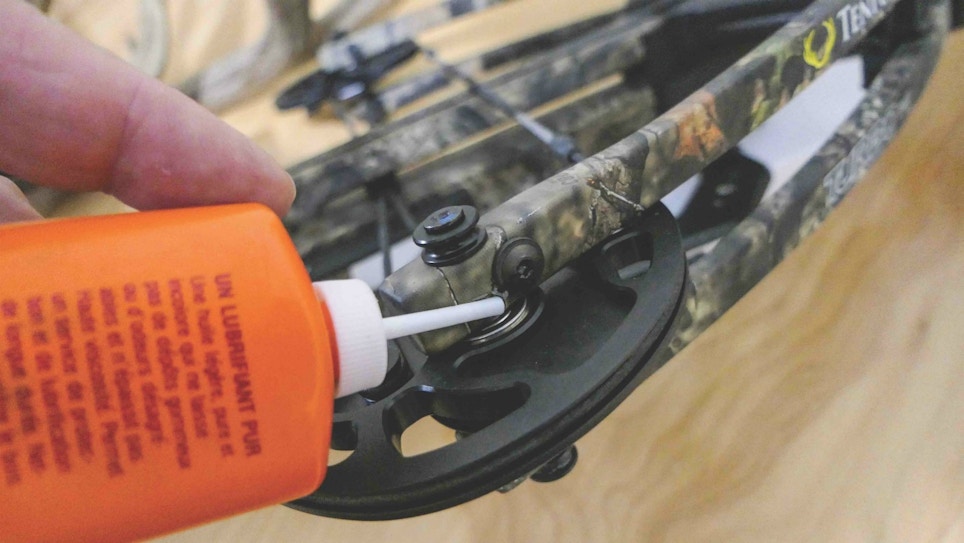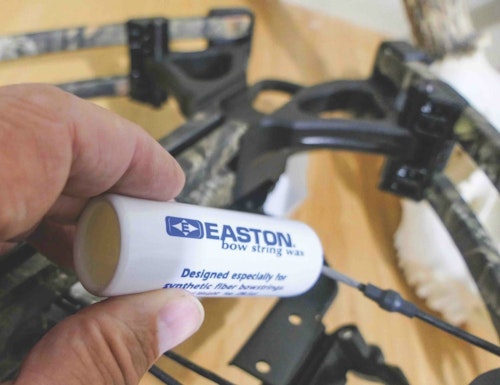
Check the owner’s manual for your crossbow for specific advice on where and how to lubricate certain components. The manual should also provide advice on the best type of lubricant.
When hunting seasons across the country wrap up, hunters can feel weary and tired after months of chasing their dreams of taking a trophy animal. It’s an annual event that brings a mix of emotions. On the one hand, you’re glad the season is over, and your obsession with hunting can be subdued as you get back to your job, family and other things that form a normal life. On the other hand, the thought of not heading to woods every day is downright depressing and gives some hunters a sense of the blues.
One could plan an entire calendar year and never have to stop hunting, if they didn’t want to. Yet, it’s good to have a little downtime. And, the end of the regular season is the best time to go over all your equipment, giving it an annual checkup.
A crossbow is a workhorse; some models could be better described as a thoroughbred — high-strung and full of energy. It’s in your best interest to pay careful attention to your archery equipment and the end of the season. It’s the perfect time to kick the tires and check the oil, so to speak.
Decision Time
If you’re intimidated to perform the maintenance yourself, try watching a YouTube video on crossbow maintenance. Another great option is to take it to a local archery shop and service dealer for a maintenance inspection. I’d recommend you watch the process and learn firsthand what needs to be looked at and what might need attention. Knowing how to do annual maintenance will allow most hunters to troubleshoot and fix problems that can arise in the field. Having intimate knowledge of your product means you can protect your investment, use it to its full advantage, and overcome the small challenges that arise when you’re in the field.
The other option, depending on what make and model crossbow you own, is to send it back to the manufacturer for service. If you read the owner’s manual, some bows need to be serviced after a specific number of shots. It isn’t always easy to keep track of how many arrows you’ve sent downrange. The end of the season, when you don’t need your crossbow the next day, is the best time to deal with any service and maintenance requirements.

DIY Maintenance
For the do-it-yourself hunter, maintenance isn’t all that difficult. I like to start at the range by firing a couple arrows downrange. Line-up your crosshair and close your eyes before pulling the trigger. Concentrate only on what you hear. Any loose screws, bolts or components are going to talk to you through vibrations. When we are hunting, we focus on accuracy, but when it comes to crossbow maintenance, listening is the best approach. A quick check of nuts, bolts or screws will give you confidence everything is tight and in good working order. Finally, perform a check on the cams, limbs, string, serving, rail, trigger mechanism, optics and all of the components/hardware that hold it together.
If your bow has a camouflage pattern on it, washing it with water is always best. I learned the hard way that any solvent or cleaning agents can dissolve the film used in the process the color or camouflage on your crossbow. Depending on the hydro-dipped process, you may want to wash with water and dry with a cotton cloth as you go. Microfiber towels are great to keep in your bow case, as they grab and hold dust. You can use them to dry clean your bow in the field and remove dirt and dust that collects during a day or two of hunting. I use a white, microfiber cloth to clean my optics. It won’t scratch the lens coatings and can remove oily impressions from fingerprints or contact with skin. Even water droplets or snow on a stormy day can be cleared away safely and efficiently. The white color also tells you when it needs to be laundered. Remember not to wash or dry with any type of fabric softener, as it prevents the surface of the cloth from holding dirt and dust and cleaning glass without leaving anything behind.
Once you have tightened and cleaned the crossbow, move to the string and serving. When you think about the tension, strain and general torture a crossbow string goes through in a year, you know they must be tough. However, even the strongest things have weak links, and a string and serving can wear over time.
Check the string wherever it contacts another mechanism. Is there wear at the point where the string is held by the trigger assembly? How does the string look where it rolls around the cam or attaches to the limb? Crossbows with recurve limbs will have different areas of concern for a string versus cams and wheels.
Check the cables as they can dry, changing the speed and overall performance of your crossbow. If you’ve hunted in the rain or snow, or even in extreme heat or cold, the cables and string could show drying or fraying wear — or all of the above.
After performing a quick once-over, wax your crossbow string. If you see exposed strands of fiber on your string, you can often stop the unraveling by applying wax or conditioner. I’m old school and still have a piece of deer hide in my maintenance kit to rub the wax into the string. The friction generates heat, allowing the wax to penetrate the fibers that make up a good bowstring. There are several products on the market, but I rely on Scorpion Venom products to condition my string. Their unique products allow you to apply conditioner with a dabber or remove it with an anti-venom product. Even their arrow release fluid works every time, no matter how fast your bow shoots.

Next, you need to oil the axle and cam bearings. You don’t need much to keep everything in good working order. Every crossbow is different, so refer to the owner’s manual for suggested maintenance. Some trigger units will also require oil to maintain safe, crisp release of your arrows.
Cocking ropes or mechanisms lift a heavy load. They are often stored in a bow case with broadheads and other sharp objects that can nick or cut the rope. Inspect the entire length of your cocking rope and replace it if needed. If you shoot a TenPoint or Wicked Ridge bow, you need to remove the cover then oil or grease the gears. Ensure the entire unit is tight to the stock and all other screws and bolts are tight. If you have small frays on the rope, you can use bowstring wax to stop it from getting worse.
If you live in an area with high humidity or store the crossbow where it could rust, be sure to add a thin layer of oil or rust inhibitor to all metal parts. It’s quick and easy to do and will ensure your bow looks like new when you take it out for your next hunt.
Maintenance is easy to do and makes the user more familiar with every part on the crossbow. The more you know about your bow, the easier it is to maintain and troubleshoot if problems arise.





